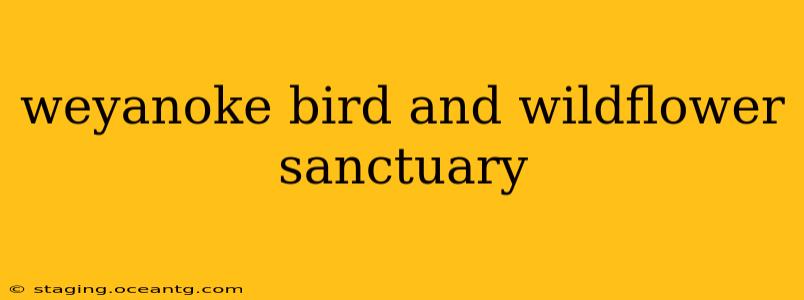Weyanoke Bird and Wildflower Sanctuary offers a tranquil escape into the natural world, providing a haven for diverse bird species and a vibrant display of wildflowers. Located [Insert Location Details Here - include state and ideally city/town, if publicly available], this sanctuary is a treasure for birdwatchers, nature photographers, and anyone seeking a peaceful connection with the environment. This sanctuary isn't just a pretty place; it plays a vital role in preserving biodiversity and educating the public about the importance of conservation.
What Makes Weyanoke Bird and Wildflower Sanctuary Special?
Weyanoke's unique charm lies in its carefully cultivated blend of natural habitats. The sanctuary boasts a variety of ecosystems, including [List specific habitats, e.g., wetlands, meadows, woodlands]. This diversity supports a wide range of flora and fauna, making it a hotspot for biodiversity. The meticulous management of the sanctuary ensures the continued thriving of both native plants and animals. This commitment to conservation is key to what makes Weyanoke so special.
What Birds Can I See at Weyanoke?
Weyanoke is a haven for birdwatchers of all skill levels. The variety of habitats supports a diverse avian population. You can expect to see [List common bird species found at the sanctuary, if publicly available; include migratory birds if applicable and their seasons]. Remember to bring your binoculars and field guide for a truly enriching experience! The best time to visit for birdwatching is often during [mention peak seasons for bird activity, e.g., spring migration, or breeding season].
What Wildflowers Bloom at Weyanoke?
The sanctuary's name aptly reflects its stunning wildflower displays. Throughout the year, visitors can witness a kaleidoscope of colors and textures. [List prominent wildflowers if publicly available, and their bloom times if known]. The sanctuary's staff often creates interpretive signage to help visitors identify the different species, further enhancing the educational experience.
Are There Trails at Weyanoke Bird and Wildflower Sanctuary?
[Answer definitively whether trails exist. If yes, describe the trails: their length, difficulty, and any notable features along the way. Mention if there are maps available. If no, explain why there are no trails and what other ways to experience the sanctuary are available].
What are the Visiting Hours and Fees at Weyanoke?
[Clearly state visiting hours and any entrance fees or donation suggestions. Include information about accessibility, if applicable]. Checking their official website [mention website address if one exists] before your visit is always a good idea to ensure you have the most up-to-date information.
Are there any guided tours or educational programs available?
[Answer whether guided tours or educational programs are offered. If yes, describe the types of programs available, their frequency, and how to register. If no, suggest alternative ways to learn about the sanctuary, e.g., brochures, self-guided exploration].
How can I help support Weyanoke Bird and Wildflower Sanctuary?
Weyanoke, like many sanctuaries, relies on the support of the community. [Explain different ways visitors can help support the sanctuary, e.g., volunteering, donations, memberships]. Your contribution plays a vital role in preserving this valuable natural resource for future generations.
Is Weyanoke Bird and Wildflower Sanctuary family-friendly?
[Answer definitively yes or no, and elaborate on why. Mention any specific family-friendly features or activities, if any exist. Consider mentioning picnic areas, accessibility, and overall suitability for children].
This information aims to provide a comprehensive overview of Weyanoke Bird and Wildflower Sanctuary. However, for the most accurate and up-to-date details, always refer to the official sanctuary website or contact them directly. Enjoy your visit to this beautiful and important natural area!
